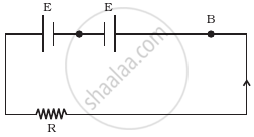Advertisements
Advertisements
प्रश्न
The graph between V and I for a conductor is a straight line passing through the origin.
Which law is illustrated by such a graph?
उत्तर
Ohm's law states that the graph between V and I for a conductor is a straight line passing through the origin.
APPEARS IN
संबंधित प्रश्न
What is an Ohmic resistor?
The graph between V and I for a conductor is a straight line passing through the origin.
What should remain constant in a statement of this law?
The filament of a bulb takes a current 100 mA when potential difference across it is 0.2 V. When the potential difference across it becomes 1.0 V, the current becomes 400 mA. Calculate the resistance of filament in each case and account for the difference.
State and define Ohm’s law.
What are non-ohmic conductors? Give one exmaple. Draw a current-voltage graph for a non-ohmic conductor.
The resistance of a nichrome wire at 0°C is 10Ω. If its temperature coefficient of resistivity of nichrome is 0.004/ °C, find its resistance of the wire at boiling point of water. Comment on the result.
A student carries out an experiment and plots the V-I graph of three samples of nichrome wire with resistances R1, R2 and R3 respectively. Which of the following is hue?

Ohm's law deals with the relationship between ______
Two cells of same emf E but internal resistance r1 and r2 are connected in series to an external resistor R (Figure). What should be the value of R so that the potential difference across the terminals of the first cell becomes zero.
What is meant by resistance of a conductor ? Define its SI unit.
